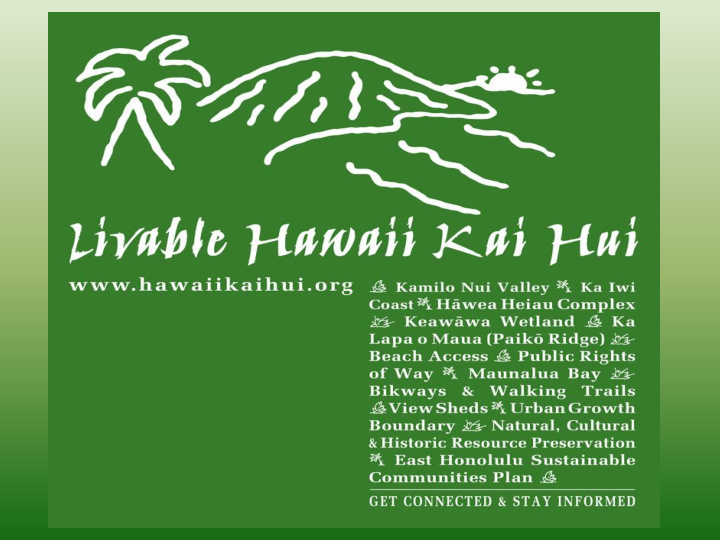



Save Kamilo Nui Valley Save Sandy Beach / Ka Iwi Coalition
Livable Hawaii Kai Hui 2004-2011 • What makes Hawaii Kai Livable? - Kamilo Nui Valley - It all started on April 22, 2004 with a street banner that read, "What Makes Hawaii Kai Livable", and a mission to help preserve Kamilo Nui Valley from residential development because it is outside the Urban Growth Boundary (UGB). In our efforts to protect the Valley, we realized from the many letters we received from Hawaii Kai residents, that there were too many quality of life and environmental issues that needed to be addressed so we established Livable Hawaii Kai Hui. We are your friends and neighbors . We are citizens like you, with valid community concerns . We connect on issues such as traffic , congestion , aging infrastructure , zoning , and urban sprawl . We are for maintaining adequate open space and the preservation of the agricultural lots in Kamilo Nui Valley and other areas in East Honolulu . Kamilonui Valley is a natural watershed that leads out to Maunalua Bay.
LIVABLE HAWAII KAI HUI CORPORATION LIVABLE HAWAII KAI HUI CORPORATION IS ORGANIZED FOR CHARITABLE, EDUCATIONAL, AND SCIENTIFIC PURPOSES, INCLUDING ENCOURAGING GRASS ROOTS ORGANIZATION, COMMUNITY AWARENESS AND EDUCATION OF LAWS, RULES AND REGULATIONS THAT GUIDE SENSIBLE GROWTH AND DEVELOPMENT TO ENHANCE THE QUALITY OF LIFE FOR RESIDENTS, FOCUSING ON THE PRESERVATION OF THE AGRICULTURAL LANDS IN KAMILONUI VALLEY, NATURAL WATERSHEDS AND ADEQUATE OPEN SPACES AND COMMUNITY STEWARDSHIP FOR THE PROTECTION OF WATERSHEDS, WETLANDS, NATURAL AND SCENIC RESOURCES AND CULTURAL AND HISTORIC AREAS IN EAST HONOLULU
East Honolulu Sustainable Communities Plan . • It's simple. Our mission is to uphold the integrity of the East Honolulu Sustainable Communities Plan . • We have many goals but our primary ones include: • 1. Educate residents on issues that impact the quality of our lives and increase community input and involvement at the Hawaii Kai Neighborhood Board meetings. • 2. Learn and share the knowledge about our wetlands, natural and scenic resources, cultural and historic landmarks. Encourage community stewardship . • 3 . Preserve the agricultural farm lots in Kamilo Nui Valley that serve as a natural watershed and open space for our community and the visitors that are passing through. • One of the best ways to learn about the growth and development of our community is to understand the East Honolulu Sustainable Communities Plan . Here you will learn about the city's vision for East Honolulu as well as understand development guidelines regarding setbacks, height restrictions, what the urban growth boundary is and why it is so important. Reading this plan is only the start... You need to couple it with keeping a watchful eye on who wants to build what, where and when, and research it to see if it is in violation of this plan. For example; did you know that Kamilo Nui Valley is outside the urban growth boundary (UGB) and that according to the city's vision it should remain that way through 2020? Did you know that from 1995 to 2020 residential growth should be limited to no more than 6,000 new residents? Did you know that commercial expansion should be limited to the boundaries of the current retail centers?
Safe for now! The Pristine Ka Iwi Coast Reclassification “Conservation” HONOLULU – Governor Linda Lingle announced that the State Land Use Commission (LUC) today voted unanimously to reclassify the Ka Iwi Scenic Shoreline from urban to conservation. The area encompasses approximately 215 acres of state- owned land on Oahu's south-east coast between Queen’s Beach and the Makapu‘u Lighthouse. The reclassification by the LUC helps ensure the preservation and conservation of the makai region of the pristine Ka Iwi Coast
Save Sandy Beach / Ka Iwi Coalition Astrid Monson Award
Keawawa Wetland Cleanup Day
Keawawa is a spring-fed estuarine wetland . Estuarine wetlands occur where freshwater meets the ocean, and the resulting brackish system is a nursery ground for young fish and shellfish, which are prey species for native birds and coastal fisheries. Keawawa wetland provides habitat for indigenous ‘auku‘u (black-crowned night heron), endemic pinao (giant green darner dragonfly), various species of native damselflies, endangered ae‘o (Hawaiian stilt), and 3 -9 of the estimated 300 to 400 remaining endangered ‘alae ‘ula (Hawaiian moorhen).
Grant from the Hawaii State Land Conservation Fund to the Livable Hawaii Kai Hui at $325,000 for the acquisition of 5 acres in Honolulu, Island of Oahu
HAWEA HEIAU
Hāwea Heiau site Petroglyphs at the site of Hāwea heiau last year. - Photo courtesy Van James
Composting Maunalua Lepo Limu Kai “Makai to Mauka” Invasive Algae Composted into Soil Amendment in Kamilo Nui Valley
Clean Up Work Days
Plant Sales, Etc.
Planning for the Future
Kamilo Nui Valley
OUR Kamilo Nui Valley Farmers group Hawaii Kai working 87 acres in East Honolulu’s Kamilo Nui Valley
Kamilo Nui Valley
Livable Hawaii Kai Hui Thank You
Recommend
More recommend